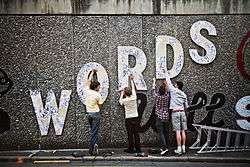Sticker art

Sticker art (also known as sticker bombing, sticker slapping, slap tagging, and sticker tagging) is a form of street art in which an image or message is publicly displayed using stickers. These stickers may promote a political agenda, comment on a policy or issue, or comprise a subcategory of graffiti.[1]
Sticker artists use a variety of label types, including inexpensively purchased and free stickers, such as the United States Postal Service's Label 228 or name tags.[2]
Creation
Label 228's are often used with hand-drawn art, and are quite hard to remove, leaving a white, sticky residue. Sticker artists can design and print thousands of stickers at low cost using a commercial printing service or at home with a computer printer and self-adhesive labels.
Sticker artists also print their designs onto adhesive vinyl, which has a strong, permanent adhesive, is waterproof, and generally fade resistant. A variant type of adhesive vinyl, called "destructible", is used by some artists. Destructible vinyl decals are primarily used as tamper indicators on equipment and shipping containers. The difficult–to–remove nature of this material is attractive to sticker artists, including B.N.E. and Obey Giant.[3]
Sticker art is a popular processing method to create artworks with a 3D effect.[4] The artist cuts vinyl sheets and foam board components with a scalpel. With this components the artist glues a sticker art collage.
Artists
Artist Cristina Vanko refers to her "I am Coal" project as "smart vandalism."[5] Vanko uses stickers to identify objects that are coal powered, spreading awareness of global climate change.[6][7]
The artist Cindy Hinant created a series of projects from 2006-2009 that combined the tradition of sticker collecting[8] and sticker bombing in works that reflected on feminine representations in popular culture.[9][10]
Sticker artists often trade their work with each other in order to expand distribution. An artist's stickers may be distributed worldwide and end up adhered in places they themselves have never been to. These trades are sometimes arranged personally or through social networking sites.
Gallery
 Sticker art in Amsterdam
Sticker art in Amsterdam The artist Above is known for applying stickers in high density patterns.
The artist Above is known for applying stickers in high density patterns. Sticker art in Sao Paulo, Brazil.
Sticker art in Sao Paulo, Brazil. Street Art in Dixon, CA taken in 2012
Street Art in Dixon, CA taken in 2012

See also
- Culture jamming
- Flyposting
- Graffiti
- Guerilla art
- Papier-mâché
- Stencil street art
- Street art
- Street installation
- Street poster art
- Street art sculptures
- Wheatpaste
References
- ↑ Marecki, Piotr (2014). Stickers as a Literature - Distribution Platform. NYC: The Trope Tank. p. 2.
- ↑ Cooper, Martha (2009-03-28). Going Postal. New York; London: Mark Batty Publisher. ISBN 9780979966651.
- ↑ Blackburn, Virginia (20 October 2007). "Poster boy with a difference". The Times. Retrieved 15 March 2014.(subscription required)
- ↑ "making of sticker art collage". whatsart.de/blog. 20 October 2014. Retrieved 31 August 2015.
- ↑ "Student art project is vandalism for a cause". The Herald-Times. 7 March 2010. Retrieved 4 April 2011.
- ↑ "Making Engaged Art: Response and Intervention on Climate Change". The Canary Project. Retrieved 4 April 2011.
- ↑ Bierut, Michael; Friedman, Thomas; Morris, Edward; Siegel, Dimitri (2010). Green Patriot Posters. Metropolis Books. ISBN 978-1-935202-24-0.
- ↑ Bent, Gala (August 2, 2007). "Interview With Cindy Hinant". Asthmatic Kitty. Retrieved 20 November 2014.
Cindy Hinant’s installations are luridly colorful collections of objects that seem to gather and spill out of otherwise ignored corners. Some of her materials are masses of bright and shiny stickers, girliness with the volume on ten.
- ↑ Zucker Saltz, Lizzie (2009). Crafting Romance. Athens: Athens Institute of Contemporary Art. p. 5.
- ↑ Watt-Grade, Susan (September 19, 2007). "Cindy Hinant: Cascades". Nuvo. Retrieved 20 November 2014.
Further reading
- IZASTIKUP:A Unique Collection of Stickers Compiled by Bo130, Microbo and The Don. Drago Media (2005) ISBN 978-88-88493-33-6
- Claudia Walde (MadC): Sticker City. The Paper Graffiti Generation (Street Graphics / Street Art). Thames & Hudson, 2007. ISBN 978-0-500-28668-5
- PEEL: The Art of the Sticker by Dave & Holly Combs. Mark Batty Publisher (2008). ISBN 0-9795546-0-8
- Stickers: Stick Em' Up by Mike Dorrian & David Recchia. Thames & Hudson (2002). ISBN 978-1-86154-247-2
- Skateboard Stickers by Mark Munson & Steve Cardwell. Laurence King Publishing (2004). ISBN 1-85669-379-1
- Name Tagging by Martha Cooper. Mark Batty Publisher (2010). ISBN 978-0981960067
| Wikimedia Commons has media related to Sticker art. |
